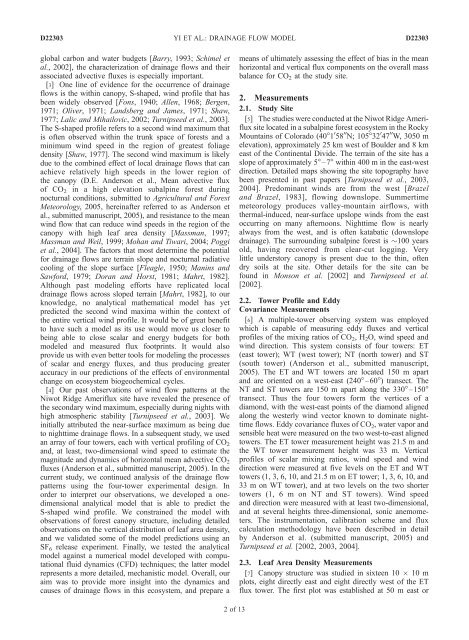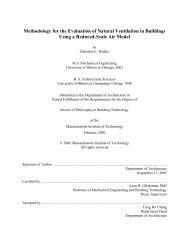Print Version - Center for the Biology of Natural Systems
Print Version - Center for the Biology of Natural Systems
Print Version - Center for the Biology of Natural Systems
Create successful ePaper yourself
Turn your PDF publications into a flip-book with our unique Google optimized e-Paper software.
D22303YI ET AL.: DRAINAGE FLOW MODELD22303global carbon and water budgets [Barry, 1993; Schimel etal., 2002], <strong>the</strong> characterization <strong>of</strong> drainage flows and <strong>the</strong>irassociated advective fluxes is especially important.[3] One line <strong>of</strong> evidence <strong>for</strong> <strong>the</strong> occurrence <strong>of</strong> drainageflows is <strong>the</strong> within canopy, S-shaped, wind pr<strong>of</strong>ile that hasbeen widely observed [Fons, 1940; Allen, 1968; Bergen,1971; Oliver, 1971; Landsberg and James, 1971; Shaw,1977; Lalic and Mihailovic, 2002; Turnipseed et al., 2003].The S-shaped pr<strong>of</strong>ile refers to a second wind maximum thatis <strong>of</strong>ten observed within <strong>the</strong> trunk space <strong>of</strong> <strong>for</strong>ests and aminimum wind speed in <strong>the</strong> region <strong>of</strong> greatest foliagedensity [Shaw, 1977]. The second wind maximum is likelydue to <strong>the</strong> combined effect <strong>of</strong> local drainage flows that canachieve relatively high speeds in <strong>the</strong> lower region <strong>of</strong><strong>the</strong> canopy (D.E. Anderson et al., Mean advective flux<strong>of</strong> CO 2 in a high elevation subalpine <strong>for</strong>est duringnocturnal conditions, submitted to Agricultural and ForestMeteorology, 2005, hereinafter referred to as Anderson etal., submitted manuscript, 2005), and resistance to <strong>the</strong> meanwind flow that can reduce wind speeds in <strong>the</strong> region <strong>of</strong> <strong>the</strong>canopy with high leaf area density [Massman, 1997;Massman and Weil, 1999; Mohan and Tiwari, 2004; Poggiet al., 2004]. The factors that most determine <strong>the</strong> potential<strong>for</strong> drainage flows are terrain slope and nocturnal radiativecooling <strong>of</strong> <strong>the</strong> slope surface [Fleagle, 1950; Manins andSaw<strong>for</strong>d, 1979; Doran and Horst, 1981; Mahrt, 1982].Although past modeling ef<strong>for</strong>ts have replicated localdrainage flows across sloped terrain [Mahrt, 1982], to ourknowledge, no analytical ma<strong>the</strong>matical model has yetpredicted <strong>the</strong> second wind maxima within <strong>the</strong> context <strong>of</strong><strong>the</strong> entire vertical wind pr<strong>of</strong>ile. It would be <strong>of</strong> great benefitto have such a model as its use would move us closer tobeing able to close scalar and energy budgets <strong>for</strong> bothmodeled and measured flux footprints. It would alsoprovide us with even better tools <strong>for</strong> modeling <strong>the</strong> processes<strong>of</strong> scalar and energy fluxes, and thus producing greateraccuracy in our predictions <strong>of</strong> <strong>the</strong> effects <strong>of</strong> environmentalchange on ecosystem biogeochemical cycles.[4] Our past observations <strong>of</strong> wind flow patterns at <strong>the</strong>Niwot Ridge Ameriflux site have revealed <strong>the</strong> presence <strong>of</strong><strong>the</strong> secondary wind maximum, especially during nights withhigh atmospheric stability [Turnipseed et al., 2003]. Weinitially attributed <strong>the</strong> near-surface maximum as being dueto nighttime drainage flows. In a subsequent study, we usedan array <strong>of</strong> four towers, each with vertical pr<strong>of</strong>iling <strong>of</strong> CO 2and, at least, two-dimensional wind speed to estimate <strong>the</strong>magnitude and dynamics <strong>of</strong> horizontal mean advective CO 2fluxes (Anderson et al., submitted manuscript, 2005). In <strong>the</strong>current study, we continued analysis <strong>of</strong> <strong>the</strong> drainage flowpatterns using <strong>the</strong> four-tower experimental design. Inorder to interpret our observations, we developed a onedimensionalanalytical model that is able to predict <strong>the</strong>S-shaped wind pr<strong>of</strong>ile. We constrained <strong>the</strong> model withobservations <strong>of</strong> <strong>for</strong>est canopy structure, including detailedobservations on <strong>the</strong> vertical distribution <strong>of</strong> leaf area density,and we validated some <strong>of</strong> <strong>the</strong> model predictions using anSF 6 release experiment. Finally, we tested <strong>the</strong> analyticalmodel against a numerical model developed with computationalfluid dynamics (CFD) techniques; <strong>the</strong> latter modelrepresents a more detailed, mechanistic model. Overall, ouraim was to provide more insight into <strong>the</strong> dynamics andcauses <strong>of</strong> drainage flows in this ecosystem, and prepare ameans <strong>of</strong> ultimately assessing <strong>the</strong> effect <strong>of</strong> bias in <strong>the</strong> meanhorizontal and vertical flux components on <strong>the</strong> overall massbalance <strong>for</strong> CO 2 at <strong>the</strong> study site.2. Measurements2.1. Study Site[5] The studies were conducted at <strong>the</strong> Niwot Ridge Amerifluxsite located in a subalpine <strong>for</strong>est ecosystem in <strong>the</strong> RockyMountains <strong>of</strong> Colorado (40°1 0 58 00 N; 105°32 0 47 00 W, 3050 melevation), approximately 25 km west <strong>of</strong> Boulder and 8 kmeast <strong>of</strong> <strong>the</strong> Continental Divide. The terrain <strong>of</strong> <strong>the</strong> site has aslope <strong>of</strong> approximately 5°–7° within 400 m in <strong>the</strong> east-westdirection. Detailed maps showing <strong>the</strong> site topography havebeen presented in past papers [Turnipseed et al., 2003,2004]. Predominant winds are from <strong>the</strong> west [Brazeland Brazel, 1983], flowing downslope. Summertimemeteorology produces valley-mountain airflows, with<strong>the</strong>rmal-induced, near-surface upslope winds from <strong>the</strong> eastoccurring on many afternoons. Nighttime flow is nearlyalways from <strong>the</strong> west, and is <strong>of</strong>ten katabatic (downslopedrainage). The surrounding subalpine <strong>for</strong>est is 100 yearsold, having recovered from clear-cut logging. Verylittle understory canopy is present due to <strong>the</strong> thin, <strong>of</strong>tendry soils at <strong>the</strong> site. O<strong>the</strong>r details <strong>for</strong> <strong>the</strong> site can befound in Monson et al. [2002] and Turnipseed et al.[2002].2.2. Tower Pr<strong>of</strong>ile and EddyCovariance Measurements[6] A multiple-tower observing system was employedwhich is capable <strong>of</strong> measuring eddy fluxes and verticalpr<strong>of</strong>iles <strong>of</strong> <strong>the</strong> mixing ratios <strong>of</strong> CO 2 ,H 2 O, wind speed andwind direction. This system consists <strong>of</strong> four towers: ET(east tower); WT (west tower); NT (north tower) and ST(south tower) (Anderson et al., submitted manuscript,2005). The ET and WT towers are located 150 m apartand are oriented on a west-east (240°–60°) transect. TheNT and ST towers are 150 m apart along <strong>the</strong> 330°–150°transect. Thus <strong>the</strong> four towers <strong>for</strong>m <strong>the</strong> vertices <strong>of</strong> adiamond, with <strong>the</strong> west-east points <strong>of</strong> <strong>the</strong> diamond alignedalong <strong>the</strong> westerly wind vector known to dominate nighttimeflows. Eddy covariance fluxes <strong>of</strong> CO 2 , water vapor andsensible heat were measured on <strong>the</strong> two west-to-east alignedtowers. The ET tower measurement height was 21.5 m and<strong>the</strong> WT tower measurement height was 33 m. Verticalpr<strong>of</strong>iles <strong>of</strong> scalar mixing ratios, wind speed and winddirection were measured at five levels on <strong>the</strong> ET and WTtowers (1, 3, 6, 10, and 21.5 m on ET tower; 1, 3, 6, 10, and33 m on WT tower), and at two levels on <strong>the</strong> two shortertowers (1, 6 m on NT and ST towers). Wind speedand direction were measured with at least two-dimensional,and at several heights three-dimensional, sonic anemometers.The instrumentation, calibration scheme and fluxcalculation methodology have been described in detailby Anderson et al. (submitted manuscript, 2005) andTurnipseed et al. [2002, 2003, 2004].2.3. Leaf Area Density Measurements[7] Canopy structure was studied in sixteen 10 10 mplots, eight directly east and eight directly west <strong>of</strong> <strong>the</strong> ETflux tower. The first plot was established at 50 m east or2<strong>of</strong>13
















